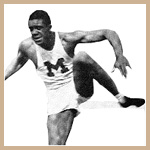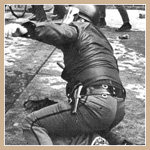| |
1888
Moses "Fleetwood" Walker becomes the first Black varsity letter winner for baseball.
1892
Athletic segregation is imposed. George Henry Jewett II is the last Black athlete to play varsity football until 1932, when Willis Ward becomes a member of the team.
  1902 1902
Colored Student Club is formed. Its aim was to pass along used textbooks, find jobs, lodging, and medical care for poor students of color.
1909
Alpha Phi Alpha establishes first Black Greek fraternity on campus.
1926
Negro Caucasian Club is formed to change University housing policies.
1932
Willis Ward becomes first Black member of the football team since athletic segregation at U of M.
1953
Albert Wheeler becomes first Black tenure-track professor.
  1970 1970
The 1st Black Action Movement (BAM) came about as students become dissatisfied with the manner in which the university addressed the issues of Black faculty, Black student representation, and the lack of resources for Black students. Submitting their demands in a ten-point platform, students pledge to "Open it (the U-M) Up or Shut It Down." What ensues is the longest and most successful protest in the history of the University, gaining national prominence and inspiring future generations.
1970
The Center for Afro-American and African Studies is created.
1971
The William Monroe Trotter House opens as a Black cultural center, supporting the interests of Black students.
1973
Henry Johnson is named Vice-President for Student Services, becoming the first African- American appointed as a vice-president in Michigan's administration.
1975
The second BAM strike begins after the University fails to fulfill negotiations of BAM I.
1987
The third BAM strike begins as a result of admissions and faculty the issues raised by student protesters. The University establishes the Michigan Mandate under President James Duderstadt. Its goal is to increase representation of Students of Color at U of M.
1993
First Black Celebratory Graduation Ceremony planned by students at the U of M.
1997
Two individuals file a lawsuit against the University because they are denied admission. Plaintiffs claim that they were victims of reverse discrimination. The lawsuit, which remains unsettled, calls into question the future of Affirmative Action programs.
2000
The Students of Color Coalition (SCC) is formed and a peaceful protest is conducted to bring awareness to continuing issues of diversity and social justice that remain at the U of M. A 14-point petition is drawn up addressing some of the historical issues facing Students of Color at U of M. The SCC sits in the Michigan Union for more than a month to protest the University's provission of space to Michigauma, a secret organization that makes offensive use of Native American culture.
2003
In a major victory for U-M announced June 23, the Supreme Court of the United States upheld the right of universities to consider race in admissions procedures in order to achieve a diverse student body.
|
|